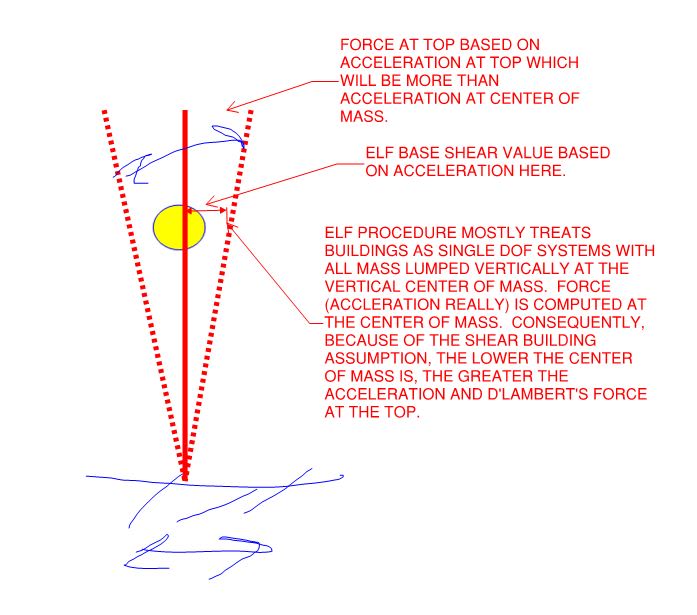Thank you to all who have helped me understand various provisions of Ch 11 and 12 of ASCE 7.
I have several things that I've interpreted, but I'm afraid I may be in trouble if I've interpreted incorrectly. I'm wondering if someone can clarify these for me.
ASCE 7-16 references follow:
1) Table 12.2-1 Type H (steel not specifically detailed for seismic...) can be used in lieu of C.4 (OMF) with only a slight increase in seismic coefficient Cs. Type H references section 14.1 for detailing requirements.
The big gaping hole (unless I've simply missed it) is that I don't see anywhere in ASCE where overstrength is required. It only states "where overstrength is required, use this method." Then it depends on ACI and AISC to instruct us on where to use it.
So, if 341 (which instructs us on when, where, and how to use Ω) is omitted in the design of a steel structure, how do I know when/where to apply it? We know from 341 that we need to apply it to connections for certain methods as outlined. But that entire book is ignored now. And I can't seem to find it in ASCE.
I also notice in 341-12 (R=3 section) does not mention Ω0 at all. It is simply a straigh-forward calculation even for the beam to column connection example.
2) Can someone explain to me the reasoning / theory behind the vertical load distribution? re: Eq 12.8-11 & 12.8-12? I've performed a dummy calculation. A two story building with equal heights per story. Equal loads per story. About 2/3 of the seismic load is applied to the roof and 1/3 to the 2nd floor. This changes with different values of k. But how is it that the load from the second floor is now distributed to the roof level?
My line of thinking is that a building over-all is a cantilever. And if we think of a cantilever beam, there is no way that loading the middle of the beam will cause more shear at the free end of a beam. Shear would only effect the beam from the point of load to the fixed end. Yet with seismic, the load in the middle of a cantilever effects the shear at the free end of the beam?
What am I missing?
I have several things that I've interpreted, but I'm afraid I may be in trouble if I've interpreted incorrectly. I'm wondering if someone can clarify these for me.
ASCE 7-16 references follow:
1) Table 12.2-1 Type H (steel not specifically detailed for seismic...) can be used in lieu of C.4 (OMF) with only a slight increase in seismic coefficient Cs. Type H references section 14.1 for detailing requirements.
If we don't need to abide by 341, then why is it addressed in part 3 of 341-12 (cordovan colored)? I noticed that it disappeared from 341-16 (blue-grey version).ASCE 7 said:(Type H) shall be permitted for systems designed and detailed in accordance with AISC 360 and need not be designed and detailed in accordance with AISC 341
The big gaping hole (unless I've simply missed it) is that I don't see anywhere in ASCE where overstrength is required. It only states "where overstrength is required, use this method." Then it depends on ACI and AISC to instruct us on where to use it.
So, if 341 (which instructs us on when, where, and how to use Ω) is omitted in the design of a steel structure, how do I know when/where to apply it? We know from 341 that we need to apply it to connections for certain methods as outlined. But that entire book is ignored now. And I can't seem to find it in ASCE.
I also notice in 341-12 (R=3 section) does not mention Ω0 at all. It is simply a straigh-forward calculation even for the beam to column connection example.
2) Can someone explain to me the reasoning / theory behind the vertical load distribution? re: Eq 12.8-11 & 12.8-12? I've performed a dummy calculation. A two story building with equal heights per story. Equal loads per story. About 2/3 of the seismic load is applied to the roof and 1/3 to the 2nd floor. This changes with different values of k. But how is it that the load from the second floor is now distributed to the roof level?
My line of thinking is that a building over-all is a cantilever. And if we think of a cantilever beam, there is no way that loading the middle of the beam will cause more shear at the free end of a beam. Shear would only effect the beam from the point of load to the fixed end. Yet with seismic, the load in the middle of a cantilever effects the shear at the free end of the beam?
What am I missing?


